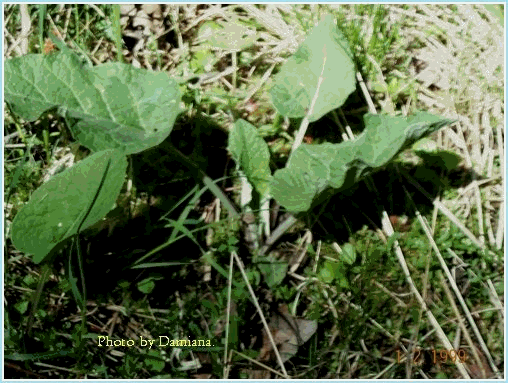
 Arctium Lappa N.F.
Burdock Root USD 1926
Arctium Lappa N.F.
Burdock Root USD 1926
2. Boerickes Homoeopathic Materia Medica.
Compiled and Edited by Ivor
Hughes.
United States Dispensatory 1926.
LAPPA. N.F. LAPPA Lap. [Burdock Root]
Lappa is the dried first year root of Arctium Lappa Linne, or of
Arctium minus Bernhardi (Fam. Composites). Lappa contains not more than 5
per cent, of its leaf bases or more than 2 per cent, of other foreign
organic matter. N.F.
Burdock Root; Radix Bardanse; Bazziea; Beggars' Buttons; Cuckoo Button; Harebur; Bardane, Glouteron, Fr.; Klettenwurzel, G.; - Bardana, It.
Although a native of Europe, burdock is abundant in the United States, where it grows on the roadsides, among rubbish, and in cultivated grounds. There are three recognized species of Arctium in North America - viz., A. tomentosum (Lam.) Schk. (Woolly or Cottony Burdock); A. Lappa L. (Burdock or Great Bur); and A. minus Schk. (Common Burdock).
The stem of the burdock is succulent, pubescent, branching, and three or four feet in height, bearing very large, cordate, denticulate leaves, which are green on their upper surface, whitish and downy on the under, and stand on long petioles. The flowers are purple, with heads globose, and in terminal panicles. The involucre consists of imbricated scales, with hooked extremities, by which they adhere to the clothing of man and the coats of animals. The achenes are oblong, somewhat compressed and three-angled, ribbed, truncate.
Burnier (Presse. Med., 1918) says that the drug must be gathered in the spring, that collected in the fall being inert.
Description and Physical Properties.
Unground Lappa. - Nearly simple, fusiform, of variable length, from
5 to 20 mm. in diameter near the crown; frequently split or in broken
pieces; externally grayish brown, longitudinally wrinkled, the crown
somewhat annulate, sometimes surmounted by a wooly tuft of leaf remains;
fracture somewhat horny; a dark cambium separating the thick brownish bark
from the yellowish porous and radiate wood, centrally hollow or containing
a white, pith-like tissue. Odor slight, becoming pyroligneous on milling;
taste mucilaginous, sweetish, and slightly bitter.
Powdered Lappai - Light brown; exhibits parenchyma cells of the cortex, medullary ray cells and wood parenchyma containing amorphous masses or sphero-crystals of inulin; yellow resin cells from the cortical parenchyma of young roots; wood fibers few; starch and calcium oxalate absent." N.F.
The commercial supplies of Burdock root are obtained chiefly from Belgium and France. They are shipped in bags containing either the whole or cut root from Brussels, Antwerp and Marseilles to the United States.
Henderschott (Proceedings of Mich. Pharm. Assoc., 1887) and also Trimble (Ph. Era, 1888, p. 133) have reported in the root a bitter, crystalline glucoside. Thos. Donaldson (A. J. P., 1890, p. 123) found 8.6 per cent, of yellow fixed oil and about 1 per cent, of white waxy matter. A small quantity of volatile oil (0.065 per cent.) has been found in burdock root according to Hansel�s Report, Oct., 1902. It also contains considerable amounts of inulin. An interesting account of burdock and its use as an edible vegetable in Japan, by Inazo Nitobe, may be found in A. J. P., 1897, 416.
Uses. - Burdock root has been employed as a diuretic and diaphoretic alterative, especially in the gouty, scorbutic, and syphilitic and scrofulous diatheses; also in various chronic skin diseases, especially in psoriasis, prurigo and acne. The fresh leaves have been employed both 'externally and internally in cutaneous eruptions and ulcerations. There is no sufficient reason, however, to believe it has any medicinal virtue.
Dose, thirty to ninety grains (2.0-5.8 Gm.).
Off. Prep.�Fluidextractum Lappae, N. F.
===============================================================
Boerickes Homoeopathic Materia Medica. San Francisco June 1927.
LAPPA ARCTIUM (Burdock)
Very important in skin therapeutics. Eruptions on the head, face, and
neck; pimples; acne. Styes and alterations on the edge of the eyelids.
Profuse and frequent urination. Crops of boils and styes. [Anthracin.]
Extremities. - Pain in bands, knees, and ankles extending downward to fingers and toes. Pain in all joints. Eruption on extremities.
Female. - Uterine displacements. An exceedingly sore, bruised feeling in uterus, with great relaxation of the vaginal tissues; apparently entire lack of tonicity of pelvic contents. These symptoms all aggravated by standing, walking, a misstep, or sudden jar.
Dose. - Tincture, to third potency.
![]()